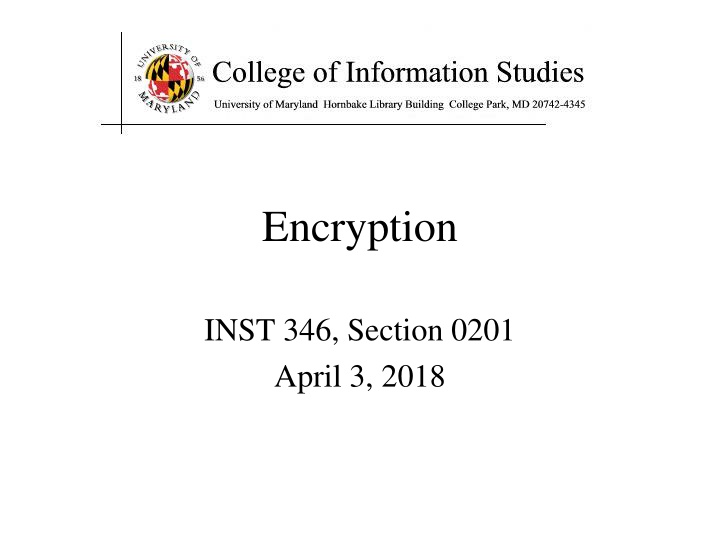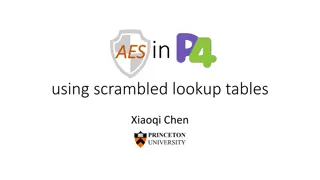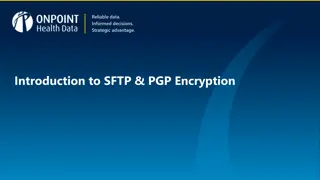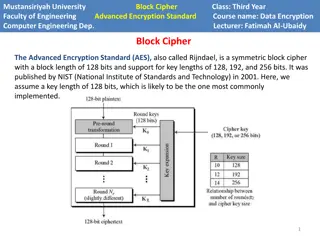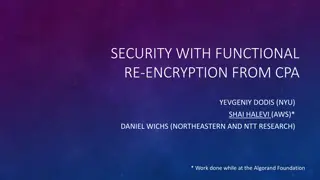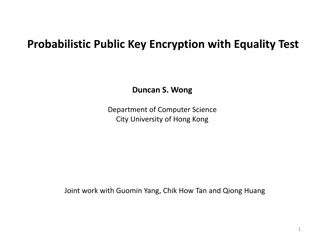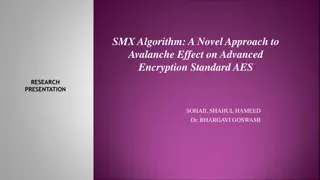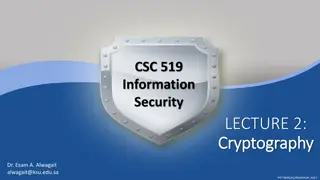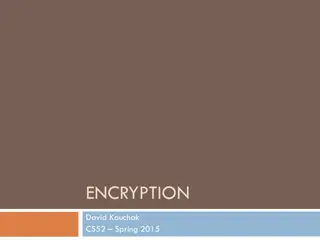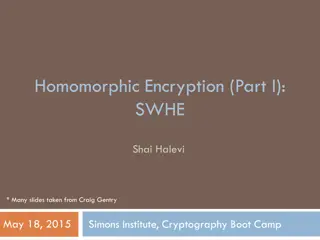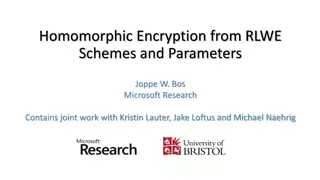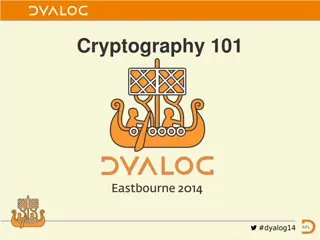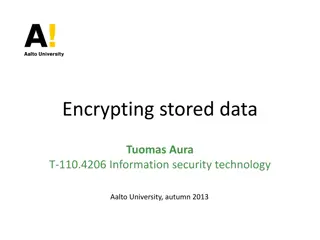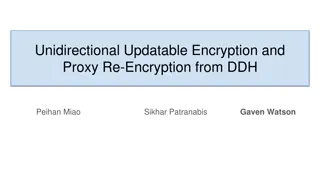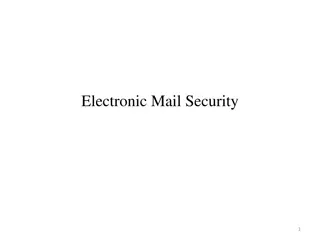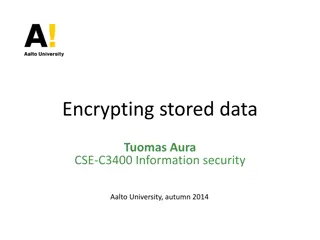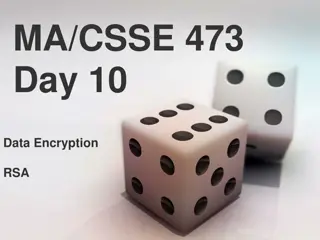Comprehensive Overview of Encryption Techniques and Algorithms
Explore the world of encryption with insights into symmetric and public key encryption, certificate authorities, secure sockets layer, substitution ciphers, block ciphers, AES, and public key cryptography. Delve into the intricacies of encryption keys and algorithms, including the AES process, Diffie-Hellman, RSA, and the requirements of public key encryption algorithms.
Download Presentation

Please find below an Image/Link to download the presentation.
The content on the website is provided AS IS for your information and personal use only. It may not be sold, licensed, or shared on other websites without obtaining consent from the author.If you encounter any issues during the download, it is possible that the publisher has removed the file from their server.
You are allowed to download the files provided on this website for personal or commercial use, subject to the condition that they are used lawfully. All files are the property of their respective owners.
The content on the website is provided AS IS for your information and personal use only. It may not be sold, licensed, or shared on other websites without obtaining consent from the author.
E N D
Presentation Transcript
Encryption INST 346, Section 0201 April 3, 2018
Goals for Today Symmetric Key Encryption Public Key Encryption Certificate Authorities Secure Sockets Layer
Simple encryption scheme substitution cipher: substituting one thing for another monoalphabetic cipher: substitute one letter for another plaintext: abcdefghijklmnopqrstuvwxyz ciphertext: mnbvcxzasdfghjklpoiuytrewq e.g.: Plaintext: bob. i love you. alice ciphertext: nkn. s gktc wky. mgsbc Encryption key: mapping from set of 26 letters to set of 26 letters
Stream and Block Ciphers n substitution ciphers, M1,M2, ,Mn cycling pattern: e.g., n=4: M1,M3,M4,M3,M2; M1,M3,M4,M3,M2; .. random initialization for each new plaintext symbol, use subsequent substitution pattern in cyclic pattern dog: d from M1, o from M3, g from M4 Encryption key: n substitution ciphers, and cyclic pattern
AES: Advanced Encryption Standard symmetric-key NIST standard, replaced DES (Nov 2001) processes data in 128 bit blocks 128, 192, or 256 bit keys brute force decryption (try each key) taking 1 sec on DES, takes 149 trillion years for AES
Public Key Cryptography symmetric key crypto requires sender, receiver know shared secret key Q: how to agree on key in first place (particularly if never met )? public key crypto radically different approach [Diffie- Hellman76, RSA78] sender, receiver do not share secret key public encryption key known to all private decryption key known only to receiver
Public key cryptography + Bob s public key K B - Bob s private key K B encryption algorithm decryption algorithm plaintext message m = K (K (m)) B plaintext message, m ciphertext K (m) B + - + B
Public key encryption algorithms requirements: . - . + - need K ( ) and K ( ) such that B K (K (m)) = m B B 1 B + + 2 given public key K , it should be impossible to compute private key K B B - RSA: Rivest, Shamir, Adelson algorithm
RSA: Creating public/private key pair 1. choose two large prime numbers p, q. (e.g., 1024 bits each) 2. compute n = pq, z = (p-1)(q-1) 3. choose e (with e<n) that has no common factors with z (e, z are relatively prime ). 4. choose d such that ed-1 is exactly divisible by z. (in other words: ed mod z = 1 ). 5. public key is (n,e).private key is (n,d). + - KB K B
RSA: encryption, decryption 0. given (n,e) and (n,d) as computed above 1. to encrypt message m (<n), compute c = m mod n e 2. to decrypt received bit pattern, c, compute m = c mod n d d e m = (m mod n) mod n c
RSA example: Bob chooses p=5, q=7. Then n=35, z=24. e=5 (so e, z relatively prime). d=29 (so ed-1 exactly divisible by z). encrypting 8-bit messages. me e m bit pattern c = m mod n encrypt: 17 24832 12 0000l000 cd d c m = c mod n decrypt: 17 12 481968572106750915091411825223071697
RSA: an important property - + - + K (K (m)) = m B B K (K (m)) B B = use private key first, followed by public key use public key first, followed by private key result is the same!
Why is RSA secure? suppose you know Bob s public key (n,e). How hard is it to determine d? essentially need to find factors of n without knowing the two factors p and q fact: factoring a big number is hard
RSA in practice: session keys exponentiation in RSA is computationally intensive DES is at least 100 times faster than RSA use public key crypto to establish secure connection, then establish second key symmetric session key for encrypting data session key, KS Bob and Alice use RSA to exchange a symmetric key KS once both have KS, they use symmetric key cryptography
Digital signatures cryptographic technique analogous to hand-written signatures: sender (Bob) digitally signs document, establishing he is document owner/creator. verifiable, nonforgeable: recipient (Alice) can prove to someone that Bob, and no one else (including Alice), must have signed document
Digital signatures simple digital signature for message m: Bob signs m by encrypting with his private key KB, creating signed message, KB(m) - - - -(m) Bob s private key Bob s message, m K B m,K B Dear Alice Bob s message, m, signed (encrypted) with his private key Public key encryption algorithm Oh, how I have missed you. I think of you all the time! (blah blah blah) Bob In practice, this is done more efficiently on message digests
Digital signatures - suppose Alice receives msg m, with signature: m, KB(m) Alice verifies m signed by Bob by applying Bob s public key KB to KB(m) then checks KB(KB(m) ) = m. If KB(KB(m) ) = m, whoever signed m must have used Bob s private key. - - + + - + Alice thus verifies that: Bob signed m no one else signed m Bob signed m and not m non-repudiation: Alice can take m, and signature KB(m) to court and prove that Bob signed m -
Message digests large message m H: Hash Function goal: fixed-length, easy- to-compute digital fingerprint apply hash function H to m, get fixed size message digest, H(m). H(m) Hash function properties: many-to-1 produces fixed-size msg digest (fingerprint) given message digest x, computationally infeasible to find m such that x = H(m)
TCP checksum: poor crypto hash function Internet checksum has some properties of hash function: produces fixed length digest (16-bit sum) of message is many-to-one But given message with given hash value, it is easy to find another message with same hash value: ASCII format message ASCII format message I O U 9 0 0 . 1 9 B O B 49 4F 55 39 30 30 2E 31 39 42 D2 42 I O U 1 0 0 . 9 9 B O B 49 4F 55 31 30 30 2E 39 39 42 D2 42 B2 C1 D2 AC B2 C1 D2 AC different messages but identical checksums!
Widely used hash functions MD5 (RFC 1321) has known vulnerabilities computes 128-bit message digest in 4-step process SHA-1 is widely used but is deprecated US standard [NIST, FIPS PUB 180-1] 160-bit message digest Collision attack with 1000 GPUs in a month SHA-2 and SHA-3 are now available Also standardized by NIST More secure, but slower (in software)
Certification authorities certification authority (CA): binds public key to particular entity, E. E (person, router) registers its public key with CA. E provides proof of identity to CA. CA creates certificate binding E to its public key. certificate containing E s public key digitally signed by CA CA says this is E s public key digital signature (encrypt) Bob s public key K B + K B + CA key K CA certificate for Bob s public key, signed by CA - private Bob s identifying information
Certification authorities when Alice wants Bob s public key: gets Bob s certificate (Bob or elsewhere). apply CA s public key to Bob s certificate, get Bob s public key digital signature (decrypt) Bob s public key + K B + K B CA + public key K CA
Secure Sockets Layer Application Application SSL TCP TCP IP IP normal application application with SSL SSL provides application programming interface (API) to applications
SSL record format 1 byte 2 bytes 3 bytes content type length SSL version data MIC Message Integrity Code (MIC) is a cryptographic hash Data and MIC use symmetric encryption
SSL cipher suite cipher suite public-key algorithm symmetric encryption algorithm MIC algorithm SSL supports several cipher suites negotiation: client, server agree on cipher suite client offers choice server picks one common SSL symmetric ciphers DES Data Encryption Standard: block 3DES Triple strength: block RC2 Rivest Cipher 2: block RC4 Rivest Cipher 4: stream SSL Public key encryption RSA
SSL overview handshake: Alice and Bob use their certificates, private keys to authenticate each other and exchange shared secret key derivation: Alice and Bob use shared secret to derive set of keys data transfer: data to be transferred is broken up into series of records connection closure: special messages to securely close connection
SSL: Setup (handshake) 1. Server authentication client sends list of algorithms it supports, along with client nonce (a random number, used only once) server chooses algorithms from list; sends back: choice + certificate + server nonce 2. Crypto negotiation client verifies certificate, extracts server s public key generates pre_master_secret, encrypts with server s public key, sends to server 3. Establish keys Client and server independently compute encryption and MIC keys from pre_master_secret and nonces 4. Authentication client sends a MIC of all the handshake messages server sends a MIC of all the handshake messages
SSL: handshake authentication last 2 steps protect handshake from tampering client typically offers range of algorithms, some strong, some weak man-in-the middle could delete stronger algorithms from list last 2 steps prevent this last two messages are encrypted
Key derivation client nonce, server nonce, and pre-master secret input into pseudo random-number generator. produces master secret master secret and new nonces input into another random-number generator: key block key block is then sliced and diced: client MIC key server MIC key client encryption key server encryption key client initialization vector (IV) server initialization vector (IV)
SSL connection everything henceforth is encrypted TCP FIN follows
